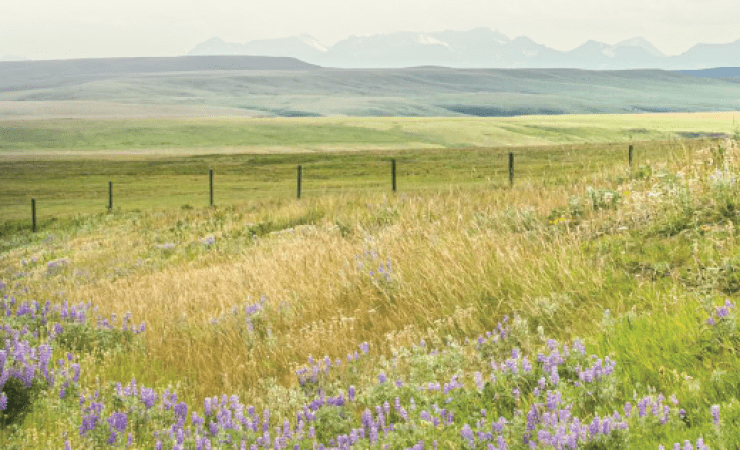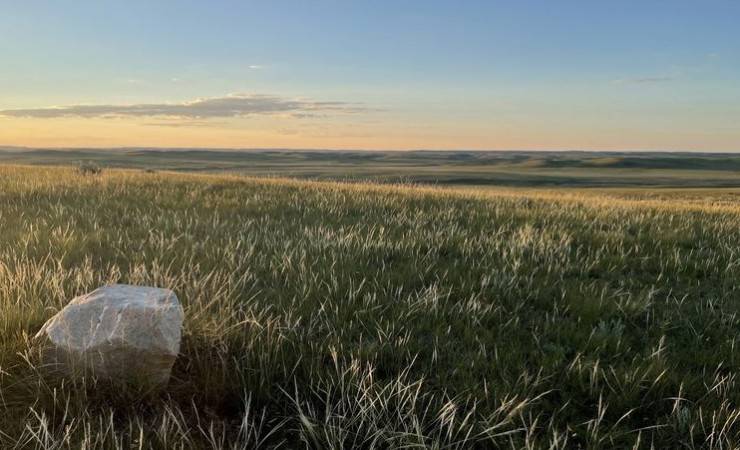The Canada Grassland Protocol (CGP) aims to protect Canadian grasslands and support producers by serving as a system in which grassland owners can produce value from the avoided emission of greenhouse gasses (GHG) that are produced when grasslands are converted to row crops or urban development.
Canadian grasslands are rapidly disappearing resulting in the emission of harmful GHGs. Temperate grasslands are one of the world’s most endangered biomes, with only 20 per cent of native Canadian grasslands remaining. In 2020 alone 1.8-million acres of grassland were lost across North America’s Great Plains, more than two football fields per minute. The main driver of grassland loss is economic as landowners can often generate more income from annual row crops than from grazing livestock.
Grasslands store large quantities of carbon in their soil but, when they are tilled, almost two thirds of that carbon is lost to the atmosphere as carbon dioxide (CO2), a prevalent GHG. Due to the speed of grassland loss, the avoided conversion of grasslands to cropland has become the most significant nature-based climate change mitigation opportunity in Canada.
How the protocol works
The CGP works to protect grasslands and support producers by producing value from the avoided emission of GHGs produced when grasslands are converted. This is done through the production of carbon offset credits (offset credits), which are tradable units that represent a set amount of GHGs sequestered or prevented from entering the atmosphere. The CGP provides a standardized approach to quantify, monitor and verify GHG reductions used to produce offset credits. These offset credits can then be sold to individuals or organizations to help them meet their emissions-reduction goals.
In exchange, landowners need to sign an agreement on land use principles that aims to preserve their grassland’s natural integrity by limiting the amount and type of development that can occur on their property. By these means, the CGP hopes to improve producers’ income by providing a new revenue system that can both support their family’s livelihood and disincentivize the conversion of at-risk grasslands.
In 2019, the Climate Action Reserve (CAR) approved the CGP for use in Canada’s voluntary carbon market. The CGP meets the International Organization for Standardization (ISO) standards and is the first offset protocol for Canadian grassland managers.
Learn more
Here is additional information about the CGP and the opportunities it represents:
The Canada Grassland Protocol: A Backgrounder
The Canada Grassland Protocol: A Backgrounder provides an in-depth overview of the protocol to help individuals decide if the CGP is right for them. Note, this document is currently only available in English.

Guardians of the Grasslands
Guardians of the Grasslands is a short documentary that describes the state of North American grasslands and the role producers play in their conservation.
Credit: Public and Stakeholder Engagement at the Canadian Cattle Association.
Canada Grassland Protocol Timeline
The Canada Grassland Protocol was developed from November 2017 through March 2023. Note, this document is currently only available in English. View the project timeline here.

2023 Wrap Up
Canada Grassland Pilot Project Wrap-Up Workshop for CGFA stakeholders provided an overview of the CGP and what it means to various stakeholders. The video recordings are available below.
- Timeline Overview and Setting the Background EN - Presented by Cedric MacLeod, Canadian Forage and Grassland Association
- Project Overview EN – Presented by Sayeed Mahadi, Viresco Solutions Inc.
- Registry Perspective EN - Presented by Mckenzie Smith, Climate Action Reserve
- Why Carbon Market Mechanisms EN – Presented by Karen Haugen-Kozyra, Viresco Solutions Inc.
- Carbon Market – A Buyer’s Perspective EN – Presented by Denise Chang-Yen, Shell Canada
- Role of the Land Trust Community EN – Presented by Craig Harding, Nature Conservancy of Canada (NCC)
- Key Learnings: Landowner Perspective EN – Presented by Shane Hansen, Hansen Grassland Project
- Project Development Perspective EN – Presented by Walter Stuart, BMO Radicle
- Key Learnings from the Project/What Comes Next EN – Presented by Cedric MacLeod, Canadian Forage and Grassland Association and Sayeed Mahadi, Viresco Solutions Inc.
- Q&A, Thank You & Acknowledgements EN
2022 Update
On February 2, 2022, the Canadian Forage and Grassland Association provided an update on the Canada Grassland Protocol.
(0:00:00) Introductions - Canadian Forage and Grassland Association
(0:13:00) Overview of Carbon Markets - Viresco Solutions
(0:20:13) Buyer’s Priorities in the Offset Markets - Shell Canada
(0:29:45) Why do Pilots Matter for Carbon Offsets - Climate Action Reserve
(0:37:15) What is the Canada Grasslands Protocol? - Viresco Solutions
(1:00:00) What is the Land Trust’s Role? - Nature Conservancy of Canada
(1:08:00) How is Carbon Value Determine? - Radicle
(1:18:53) What has the pilot achieved in its first year? - Radicle and Viresco Solutions
(1:22:33) What’s next? - Canadian Forage and Grassland Association
Pilot Project Launch
Significant amounts of carbon are released when grasslands are converted for other purposes. It is estimated that Canada’s grasslands currently store ~1.5 billion tonnes of carbon. (Canadian Roundtable on Sustainable Beef (2015) National Beef Sustainability Assessment).
In March 2021, during Prairies Got the Goods Week, a diverse group of organizations announced the Canada Grassland Protocol Pilot project to test and refine a carbon offset methodology, or protocol, to enable the generation of carbon credits for carbon stored by conserved grasslands in Canada. Hosted by SaskEnergy and Wildlife Habitat Canada, Retaining Canada’s Grasslands Using Carbon Offset Markets and a Roadmap to Quantify Grassland Soil Organic Carbon, provided an overview of the CGP and what it means to various stakeholders.

Carbon, what is in it for my ranch?
Information for new land trusts
Land trusts who would like to work with the Canada Grassland Protocol (CGP) should read the protocol available on the Climate Action Reserve’s (CAR’s) website and reach out to the Canadian Forage and Grassland Association (CFGA) to learn more about the GIS-based screening tool.
The Canadian Grassland Protocol Project (CGPP) team developed the GIS-based screening tool to make it easier to estimate a property’s eligible project area. It streamlines the process by searching for key eligibility requirements and enables land trusts to estimate the grassland carbon opportunities of a property considered for a conservation easement.
Further details of this GIS-based screening tool could be provided upon request by emailing [email protected].
The CFGA and Viresco Solutions led the CGP’s development with support from Agriculture and Agri-Food Canada, the Alberta Beef Producers Association, BMO Radicle, Ducks Unlimited Canada, Legacy Land Trust Society, Nature Conservancy Canada, Shell Canada, Southern Alberta Land Trust Society, Saskatchewan Stock Growers Association, Brightspot Climate, Climate Action Reserve, and Regrow Ag.
